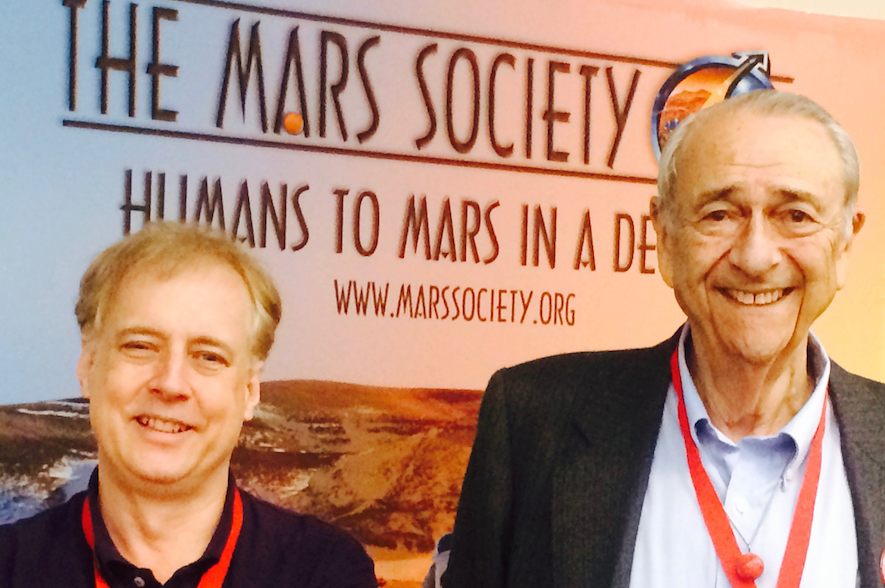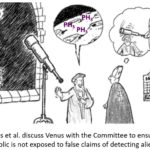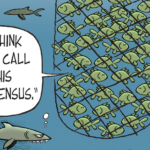Cite as: Benner, S. A. (2021) “Gilbert Levin and Life on Mars”. Primordial Scoop, 2021, e1011. https://doi.org/10.52400/AWXL3848
This blog often remarks on current events, and occasionally comments on what those events suggest about how science is practiced. Let us do the first today first.
As a major event worth noting under any circumstances, last summer saw the passing of Gilbert Levin, a good friend.
In 1967, long before I met him, Gil founded Biospherics Research (now Spherix). He served as CEO and President until 2003, remaining as Chairman of the Board until 2007.
At Biospherics, Gil designed with Patricia Straat a part of the 1976 Viking life detection suite of instruments for Mars. Their instrument delivered seven radiolabeled compounds to the Martian soil and looked for their conversion to radioactive CO2. Radiolabel release was designed to indicate the presence of actively metabolizing Martian life. The logic is clear: If I were to feed you the same radioactive food, you too would exhale radioactive CO2.
Remarkably, label release was observed by Viking on Mars. The surface exhaled radioactive CO2 after being fed radioactive food. After heating or otherwise human-handling the soil, label release slowed and stopped.
I myself got to know these results in detail after moving back to the US from Switzerland in 1998. Sensing a warm body dedicated to helping out NASA, Michael Meyer dragged me down to the Lunar and Planetary Institute in Houston to serve on one of his NASA grant reviewing panels.
In the evenings, I had access to the LPI library. There, I found a log of the Viking mission, bound volumes filling many shelves. Not being one to go drinking in the evening, I spent several enjoyable evenings paging through the record and learning about Gil’s contribution to planetary exploration.
It was remarkable.
Not the life detection results per se, but rather the response to them as they had arrived in real time to the mission team. Label release was thought to be an affirmative indication of active life, under the view that all life must metabolize. When the experimental result came back affirmative, I expected to see excitement reflected in the logs.
Especially since two other life detection experiments also gave results consistent with Martian life. Looking for the Martian equivalent of photosynthesis, O2 was released from the surface upon its humidification. This too was thought to be an affirmative sign.
A third experiment looked for the fixation of radiolabeled CO2 and CO. These gases were fed to the surface in the ratios found in the Martian atmosphere. Carbon fixation was observed, another affirmative for life.
Norm Horowitz, who designed the last experiment, argued that his was the best experiment to detect Martian metabolism. His argument? The carbon fixation experiment was performed under conditions that least perturbed the Martian environment.
Three life detection experiments. Three positive results, with a few perplexities that we will ignore for the moment. Life had been discovered on Mars, at least under the terms by which it had been sought.
Reading the logs, I asked myself: “Why do I not know about this?” And: “Since I do not know about this, how could I possibly be competent to referee NASA proposals for Michael Meyer?”
Further, the curious historian in me asked: “What were these people thinking in real time about these results as they came in?”
Remarkably, to the extent that the record showed emotions at all, it did not show happiness or excitement. Rather, it suggested fear.
As I have written elsewhere [1], these three experiments exploited the “metabolism theory of life.” Under this theory, if something is alive, it must carry out chemical reactions. Of course, since biology is chemistry “all of the way down”, non-biological chemistry might generate false positives. This was well known at the time, and was one reason why three different reaction classes were sought. Indeed, an experiment to detect a fourth class was proposed, but ended up not flying.
Viking also carried an experiment designed to exploit a different theory of life: the “reduced carbon” theory [1]. This was a tad more Earth-o-centric. At a very high level, all life must effect chemical transformations. The reduced carbon theory goes beyond this, assuming further that reduced carbon (and not, for example, reduced silicon) is required to catalyze these transformations.
To look for life under the reduced carbon theory, Klaus Biemann and his team designed a gas chromatograph-mass spectrometer (GC-MS) not to look for metabolism, but rather to find the reduced carbon compounds thought to be essential for bio-metabolism. It was designed to scoop up soil, heat the soil to 500°C, pass any organic fragments emerging through a column with a flow of H2 gas, and detect any organic products by mass spectrometry.
It took a while to get a sample for the GC-MS scooped up. The instrument designers had expected the Martian soil to collapse back on itself, allowing a second sample to be scooped at the same position as a first sample. As it turned out, the second scoop scooped only air in the hole left from the first scoop. Thus, the affirmative life detection results remained unchallenged for some time as the scooping arm was re-programmed. The log shows tension mounting.
But eventually, a scoop of sample was delivered to the GC-MS. And what did it see by way of reduced organics on Mars? In a word … nothing. Well, not exactly nothing, but that is how the contemporaneous mission logs saw the result.
So what happened? To the extent that the mission logs conveyed emotion, they now conveyed “relief”. The scientists no longer needed to announce the discovery of Martian life. The “reduced organics” theory of life became stronger than the “metabolism” theory of life. Biemann’s results trumped the Levin-Straat results.
Further, as soon as the GC-MS result was in, the logs report people finding non-biological explanations for all three affirmative life detection results.
Or as stated in Gil Levin’s bio, “a consensus did not accept his results as proof of life.” [2]
And there is the most dangerous word in science: consensus.
Why is “consensus” dangerous? It is pretty obvious if you think about it.
Models of the natural world center around propositions. Members of communities come to hold beliefs about the truth (or not) of various propositions in various ways; discovery, education, and indoctrination are ways to enforce consensus beliefs.
Of course, the consensus can be correct. If it is, no truly impactful science is left to be done in this particular space. Of course, as Thomas Kuhn pointed out, normal scientists will still do normal science revisiting the consensus. Easy to fund. Low risk to perform.
Alternatively, the consensus can be wrong. This, of course, presents the opportunity to do some impactful science.
But research that opposes a consensus is higher risk and more difficult to fund. The consensus can fight back. Especially if it is institutionalized. Individuals will go to their graves believing what they were taught in school to believe. But institutionalized consensus will send others to their graves, to defend the institutional consensus.
The Viking scientists fully understood the limits of their tests. For example, reduced organic materials fall via meteorite every day to Mars. Horowitz had pointed out that a positive GS-MS result would likely do nothing more than re-discover these. And so the “failure” of the GC-MS experiment to find those meteorite organics was a surprise needing explanation, before it could contradict the “metabolism” results.
And so it was explained. The failure of the GC-MS to identify (even) meteoritic organics led to the proposition that these had been destroyed by ultraviolet light. This then evolved to the proposition that the surface of Mars is oxidizing, leading to the oxidative destruction of organics.
And not just oxidizing. To account for the results, the Martian surface had to be rather oxidizing. A puzzle, since the radioactive carbon fixed in the Horowitz experiment evidently survived that oxidant. Another paradox that I realized, sitting cross-legged on the LPI library floor, had been overlooked.
But it did not end there. As I read the logs, with a bit of horror, I realized that the GC-MS results themselves had been misinterpreted for other reasons. Organics, including meteorite organics, and especially aromatic meteorite organics, often become refractory upon mild oxidation. They do not easily become further oxidized, which allows them to accumulate. They also have a hard time flying into a GC-MS. On Earth, an example is the organic mineral mellite, a benzene aromatic ring with six carboxyl groups attached. No one mentioned in the logs seemed to know about this.
Back in Florida, Kevin Devine and I worked with the mass spec group to replicate the GS-MS with likely organics derived from meteorites. We showed that Viking could have been sitting on a pile of mellite and related organic molecules, and still not seen them.
Further, long-term exposure to oxidizing environments converts chloride (as in table salt) to perchlorate. Innocuous to organics at low temperature, perchlorate sets them afire at 500 °C. Unanticipated in 1976, perchlorate was actually seen by NASA’s 2008 Phoenix Lander. Replication of the GC-MS experiment on Earth showed that the Viking procedure used to prepare the sample burned any organics that may have been there [3].
Today, we know that the GC-MS results did not show the absence of organics on Mars. They were certainly there in refractory form. Further, those that were there were combusted by the perchlorate at the temperatures used to try to get them into the GC-MS.
Now, we must follow the logic. If the GC-MS results did not rule out the presence of organics on the Martian surface, we can no longer argue (as Horowitz himself did in 1977) that the GC-MS results “weight heavily against” the view that the Levin-Straat results were biological in origin. And since no other results emerged from Viking that weighed heavily against that view, the label release, O2 release, and carbon fixation results regain their status of being affirmative biosignatures, possibly with some caveats.
In short, the consensus, that Viking eliminated the possibility of life on Mars, … was wrong. Because one assumption in its Aristotelian logical progression was wrong.
Gil went to his grave asking the questions that became obvious after our 1998 experiments and the Phoenix mission: With the GC-MS experiments no longer ruling out the presence of reduced organics, why (in the hell) did the community consensus not return to the status quo ante? Why did the metabolism results not now drive the search for extant life on Mars?
Gil never got answers to these questions. To understand why, we must explore a bit the intellectual limitations of committees, communities, and consensuses.
It is easy to forget why we believe things that we believe. For an example, ask Ph.D. candidates at their final defense why they think that water is H2O. In my experience, they never know, but they “know” that they know.
This goes double for communities. A consensus view of of the truth of propositions enters textbooks. Students are graded highly if they memorize the consensus. Peer reviewers of papers and grants reinforce the consensus.
Because Michael Meyer did not recruit me to serve as a NASA reviewer until 1998, it took 20 years before my lab did the first experiments to show that the GC-MS results had been misinterpreted. Therefore, the NASA community had 20 long years to forget why it “knew” that Viking 1976 “showed” that life was absent on Mars. The community forgot the role that the GC-MS result played in the logical progression that led to this “consensus”. So even after the centerpiece of that logical progression had evaporated, the consensus remained.
And dislodging false “knowledge” from a community consensus is nearly impossible.
This is illustrated well by the report released just this week from a workshop that NASA commissioned to institutionalize the “consensus” surrounding how life detection results should be evaluated.
The report used the Levin-Straat experiments as an example of “life detection gone wrong” to justify the need to define a “biosignature detection framework”. The consensus experts wrote (page 6) that if only (if only) a “biosignature detection framework [had been] applied to the label release result [on Mars] at the time of discovery”, it would have encouraged (fools like) Levin, Straat, Horowitz and the others to have “reduced confidence in the potential biosignature detected.”
And why did the “consensus” authors just this week, in October 2021, think that the Levin-Straat result merited “reduced confidence”?
You guessed it: Because, as the workshop participants wrote, “no organics were detected by Viking’s Gas Chromatograph-Mass Spectrometer”.
Yes, the “expert consensus” in 2021 still holds fast to the incorrect 1976 interpretation of the GC-MS results. So much so that it is prepared to ensure that this misinterpretation is enforced on NASA missions, programs, and funding. More on this in later posts.
So why is the “community”, then and now, so fearful of an observation that might be interpreted as evidence for life? Again, we must understand the conservatism of institutions whose touchstones are committees and consensuses.
By all accounts, NASA considered the 1976 Viking success to be a programmatic failure. While the exact words are rarely used, its culture came to think that by making “life detection” the goal, the mission had aimed too high. Because Viking (as it was decided) failed to “prove” the existence of Martian life, it was seen in this particular culture to have been a disappointment. Notwithstanding Viking’s actual (and brilliant) success.
Under this logic, for 20 years, NASA stopped looking for life on Mars. Therefore, in 1996, when David McKay reported cell-like structures in a piece of Martian rock, NASA was unprepared to answer the question that President Clinton posed to the public. Does the “cell theory of life” trump the Viking “reduced carbon theory” observations that “disproved” the presence of life on Mars?
NASA set up an astrobiology institute to bring itself up to speed. But still, NASA launched missions with the explicit statement that they were not looking for life. Instead, NASA told the public that they were looking for “habitability”, or hoping to “follow the water”.
The result was a half century of no progress since Gil Levin, Patricia Straat, Norm Horowitz and the others got the first evidence that Mars might hold a biosphere. More time has elapsed between Viking and today than elapsed between Wiley Posts’ flight around the world and Viking. It has taken NASA longer to again consider searching for Martian life than it took the German Empire to rise, invent the automobile, immolate itself in World War I, and collapse.
But there is good news. In November 2019, 43 years after Viking, NASA finally held a workshop in Carlsbad New Mexico to ask how we might (once again) search for extant life. Even so, NASA peer review panels still will not support the development of agnostic life finders, preferring to fly drones on Mars.
But SpaceX, the UAE, the Chinese, the Breakthrough Foundation, others, might pick up the ball.
So Gil might get to have the last laugh.
[1] Benner, S. A. (2009) Life, the Universe, and the Scientific Method, Gainesville, FfAME Press. 312 pp.
[2] http://www.gillevin.com/
[3] Navarro-Gonzálex, R., Vargas, E., de la Rosa, J., Raga, A.C. & McKay, C.P. (2010) Reanalysis of the Viking results suggest perchlorate and organics at midlatitudes on Mars. Journal of Geophysical Research, Planets, 115 (E12),.
[4] https://www.npr.org/sections/goatsandsoda/2016/07/30/487925796/it-takes-a-village-to-determine-the-origins-of-an-african-proverb




Dear Steve,
Thanks for this tribute to Gil and others who devoted many years trying to get an open-minded hearing on the Viking results. I spent countless hours with Gil talking about these issues, and many more reading his proposals and commentaries. He was no fool, yet few would listen to his view (which you echo) that the GC-MS results were irrelevant because the instrument lacked the necessary sensitivity.
Another interesting note is that his original instrument design included both D- and L-reagents; he argued that a difference between the responses would point to life with a chiral bias. But the instrument was scaled back to a single chiral reaction. His original design could easily be miniaturized and flown as a more convincing life-detection experiment. Maybe some day…..
Thanks again,
Bob
Yes, chirality discrimination for D- and L-lactate or D- and L-alanine would have added a powerful dimension to the analysis.
But as I often remark, the only NASA mission planning meeting that is important to attend is the LAST meeting. This is the meeting where they take out the important instruments that you thought were going to fly.
For example, in 2000, after I made a presentation at JPL about the irrelevance of the GC-MS and described the refractory organics likely present on Mars, we almost got a Raman spectrometer onto the Mars Exploration Rover. Steve Squyers during my talk leaned over Charles Elachi and whispered that the Raman was exactly what was needed to detect the refractory organics.
But I neglected to attend the last mission planning meeting. No Raman flew. So 20 years later, NASA White Papers STILL regard the GC-MS results as dispositive.